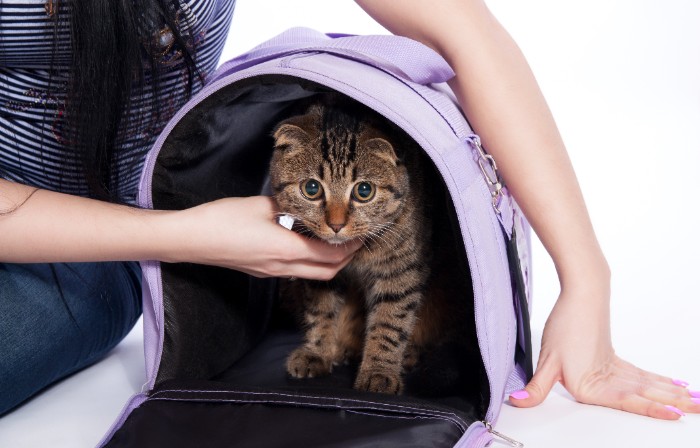Traveling With a Cat: Tips to Avoid a Pawful Time
Many people like to travel with their pets. While cats are most comfortable in their home environment, some cats can adapt rather well to travel. And some really, really don’t. (We have the cat scratch scars to prove it.)
Overall, we discourage traveling with cats because it can be so stressful for both the cat and the cat owner. That said, there are times when traveling is necessary and there are some cats who LOVE hitting the open road.

How to Avoid a CAT-astrophe
Planning ahead will help you and your furry friend have the best experience possible. Traveling or moving with cats can be easy if you are prepared. If your cat has an aversion to travel, this is especially important to reduce their anxiety. The sooner you start packing the more relaxed YOU will be when it's time to leave.
Packing
Packing for a trip or a move is STRESSFUL! I never know what to pack, how many pairs of shoes to bring, and exactly what I’ll be doing. Luckily cats don't have a wardrobe, aren't typically big on ‘going out,’ and have a routine diet. So, their list, while surprisingly long, isn't rocket science.
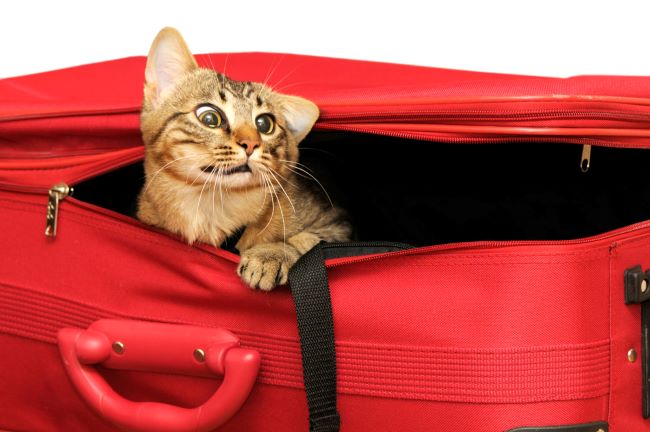
Food, Water, & other Necessities
Having access to your cat's food, treats, and fresh water is a must. Even if they don’t eat much while on the road (or in the air, or on the rails…however you’re traveling) easy access is important when you reach your destination.
-
Collapsible bowls combined with a collapsible water bottle (it’s also good for the environment and perfect for FAA travel requirements) are a space-saving combo.
-
Bowls that attach to the crate door for limited spillage are an option, too.
-
Treats and any of your cat's things that bring it comfort should be within reach.
-
If your cat eats wet food, it's easiest to bring tear foil packaging or pull tabs so you don't have to pack a can opener.
-
If your pet requires medication, keep it in an easy-to-access location as well and pack more than what you need just in case the trip goes longer than expected.
Having a bag for all the things you need while traveling provides quick and easy access. Which makes your cats’ lives easier (and honestly, isn’t that what having a cat is all about?).
Litter Box
If you are moving with cats, your pet is older, or your trip is long-distance, you’ll need to have a potty plan. I suggest having a litter box available for your cat when you make a stop. I say this, knowing that best-laid plans aren’t always on a cat's agenda. So, while you plan for bathroom breaks, know your cat may have other ideas.

Here are a few options we recommend:
-
A travel litter box (side note, these are also great to have on hand for your cat’s disaster preparedness kit).
-
Disposable litter trays are quick, easy to use, and meant to be disposed of.
-
A smaller, shallow plastic storage container with a lid can be used as a litter box (but they do take up more room than either option above).
-
If your cat's space is big enough, you can put their litter pan in with them.
-
If your trip is less than two hours, a puppy pad is all you should need (juuuust in case).
-
If your cat is comfortable on a leash and travels well, you can visit a rest stop for their business. Although, it may be louder than your cat is used to and could be scary.
-
Don’t forget litter, a scoop, and trash bags for disposal (I prefer to reuse plastic grocery bags).
Be Prepared for ALL Scenarios, Including a Cat Getting Lost
Becoming separated is one of the scariest things that can happen to a pet parent and their fur kid while traveling or moving with cats. While we hope this never happens, it’s best to be prepared, than regret you didn’t take a small step to help you reunite with each other.
Visible Identification
If you don't normally have a collar on your indoor cat, now is the time to start! Cats that go outdoors should already be wearing a collar with up-to-date identification.
Not only are collars a super easy way to give your cat flair, but an ID tag gives anyone who may find your lost feline the ability to contact you immediately. That is, as long as the tag information is correct.
A digital ID tag allows immediate update of contact information online, rather than having to replace a tag. With a PetHub digital ID you can also include several contact numbers for your pet, which is especially helpful when your cat's moving between locations.
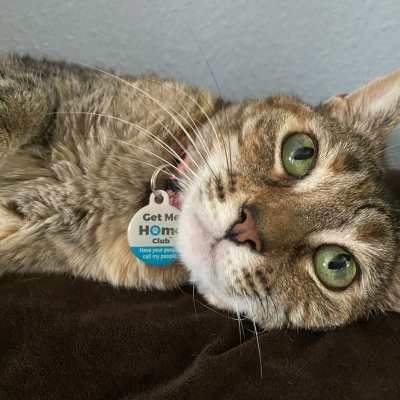
Crate cards can also be incredibly helpful for those traveling on planes, trains, or other public transportation that might see you separated from your purr kid. PetHub offers a digital crate tag that can be linked directly to your cat’s existing profile - giving you one convenient place to update multiple identifications.
As a precaution, we ALWAYS recommend breakaway-style collars. Yes, this means if your cat gets caught in something they’re running naked, but hopefully, someone will find them before that happens. If not, a naked cat is better than an injured cat.
Invisible Identification
Microchips are incredibly helpful when other forms of identification have failed (i.e. is lost). If you don’t already have one, contact your vet or local shelter to have one injected (it sounds scary, but it’s painless).
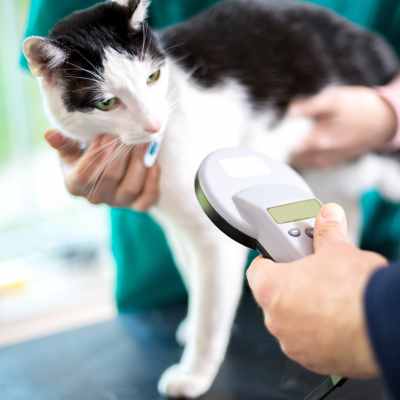
Is your pet already chipped? Confirm your contact information is current with your cat’s microchip provider. If you don’t know who that is, reach out to whoever chipped your cat. They should be able to assist you.
Transporting Your Cat
Even a harness and leash trained cat can get stressed on a trip. A cat carrier gives them a safe space while spending time traveling.
Cat Carrier
Soft side bags allow cats to be buckled in through a seat belt. Traditional hard side cat carriers are very sturdy. Both are great options. Regardless of which you choose, it should be large enough for them to stretch out, turn around, and lie down. Multiple cats [this is important] that get along well may transition easier in a larger dog kennel and a cozy cat bed that will accommodate all of them.
If you are using public transportation, it’s important to check with your transportation provider on type and size requirements for carriers.
Make it Cozy
Help your cat reduce stress and stay calm by making the area soft. Pad the bottom of the cat carrier with a cat bed, blanket, fluffy towel, or even an old sweatshirt. Something that you have worn will smell like you and likely increase your cat’s comfort level. You can also pick up calming aids to help relax your purr kid.
 Not all cats love the idea of a cat carrier. If yours is in this category, help your cat adjust. In the weeks leading up to your trip, help your kitty warm up to the idea by giving them free reign to go in and out of the carrier as they please. Feed them in or around the carrier and leave the carrier door open so they can walk in and out while they're in your house.
Not all cats love the idea of a cat carrier. If yours is in this category, help your cat adjust. In the weeks leading up to your trip, help your kitty warm up to the idea by giving them free reign to go in and out of the carrier as they please. Feed them in or around the carrier and leave the carrier door open so they can walk in and out while they're in your house.
Know the Rules
If you're traveling on public transportation, including airlines and trains, be clear on what is required of you ahead of time, including crate or carrier regulations, fees, and medical record requirements. Know if your cat can travel with you, and how and when to reserve space for them.

No matter how you are traveling, know your destination’s rules about pets. Do your research so there are no surprises and you and your cat aren’t separated for your entire trip or extended time into your move.
Home Away From Home
News flash! Cats love to sleep. But, like many people, they may have a harder time sleeping away from home. To help keep them relaxed and comfortable have, their basic needs available: litter tray, cat food, and water. Give them a place to seek refuge and provide a favorite blanket or toy that smells familiar to them. You may also want to include a few treats.
Know Before You Go
If your plan includes staying in a hotel or Airbnb, even if you’ve stayed there before, confirm it’s pet-friendly. Some lodging requires vet records, additional deposits, or other requirements. Avoid additional stress on both you and your cat by clarifying the pet rules ahead of time.

If you are staying with family members or in someone else’s house, share your plan to travel with your cat ahead of time. Inquire if they have other pets. Another animal in a new home is likely to be stressful for your cat. You don’t want to add a situation that could cause injury if that animal isn't welcoming to other animals in their home.
If you must stay in a home with new animals, keep your cat indoors and contained in one safe room, remembering that they can easily slip through narrow gaps so be sure to check the door each time you open and close it. This will ensure your cat safe and reduce their stress. Keep in mind, an anxious cat is more likely to flee stressful events so the calmer you can keep them, the better.
A Healthy Cat is a Happy Cat
Before you are scheduled to leave, visit your veterinarian. Many states have specific vaccination requirements. If your cat needs to be brought up-to-date on vaccinations, you’ll want to do that at least two weeks before your trip.
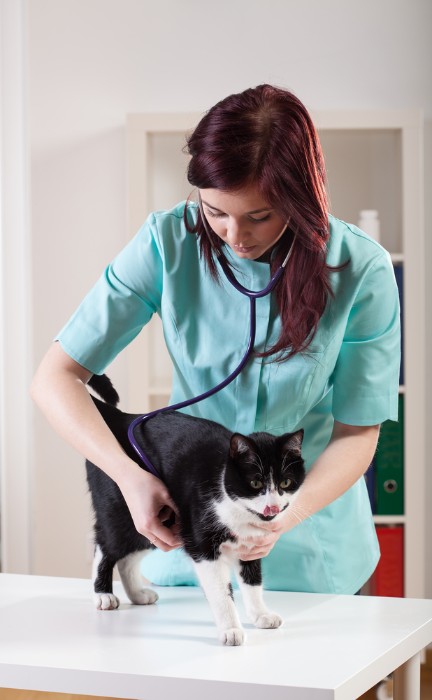
When traveling or moving to a new state, your cat may need a health certificate and/or proof of rabies vaccination. Talk to your veterinarian in advance to learn what's needed for a certificate.
Keep essential paperwork in a safe and easy-to-access spot, like a travel binder (or the handy travel bag we mentioned above).
If you are a PetHub member, you can upload your cat’s important documentation, including license and rabies info to their PetHub profile, giving you easy access to digital copies. You can also list your vet’s telephone number as one of your cat’s Safety Circle numbers.
If you've traveled with your cat before and know your cat's stress level will be high, you can also speak with your vet about a mild sedative to help keep your cat calm or, possibly even stress-free.
Hittin’ the Road
Woo-hoo! It’s moving day or trip day! You and your cat’s bags are packed, but now what? Before loading them into their carrier and heading off…there are a few extra steps to take to make sure your cat is as comfortable as possible.
Last Minute Preparations
- Keep your cat inside the night before you leave. You don't want moving day or trip travel delayed due to missing pets.
- Don’t feed your cat the morning of your trip. It can lead to an upset tummy or motion sickness. Feed them at a stop and only after you gauge how your cat handles car rides.
- Give meds as required. Regular medications, as well as any mild sedative, should be given at the time that's directed.
- Shower your cat with love and exercise (play). Help relax your cat by giving them playtime before you leave. A tired cat will travel and be less stressed.
- Go potty. Like kids, having your purr kid use the bathroom before you leave helps reduce the likelihood of accidents.
- Pack your cat last, preferably in the back seat so their time in the crate and vehicle is as little as possible. Never put a pet in the back of a loaded moving truck or van.
Keep Calm and Carry On
Now that you’re on the road, your focus is to get to your destination safely, while keeping everyone as relaxed as possible.

Because cats do not perspire, they will pant when their heartbeat is elevated and when they are hot. It’s normal to see some panting because a car ride is very stressful for most cats.
Concerned PetHub Wellness Tool members can utilize the ‘Ask A Vet’ feature for immediate veterinary advice if they are worried about panting or any other symptoms they may be worried about.
If you see excessive panting, drooling, or other extreme signs of distress, stop as soon as it is safe and call your veterinarian.
Feline Friends on the Road
Most cats may meow for up to an hour as you begin your trip, but if you have a chatter box who talks the whole trip, you may way to take steps to make them feel more secure. Covering the cat carrier with a dark, but breathable fabric, while leaving the door uncovered, can help your kitty feel safer.

You can also help your cat stay relaxed by playing soothing music and keeping it at a reasonable level. Remember, cat’s ears are much more sensitive to sound than ours.
The most important thing you can do now is arrive at your destination safely. Although counterintuitive to everything you know as a pet parent, try to ignore your purr kid as much as possible so you can focus on driving.
Take a Break
If traveling a long distance, it’s important to give your cat the opportunity to potty and eat/drink. It’s also a good opportunity for you to do the same.
Never leave your cat unattended at any point during the trip! If you are traveling solo, especially by car, this can be tricky. I suggest traveling with two sets of car keys so you can lock your car, but still leave heat or A/C on.
If you need to travel alone and don’t have a spare set of keys, I suggest getting digital help. Track vehicle temperatures during your trip using a health monitor, like Waggle’s Pet Temperature Monitor. It monitors humidity and temperature and will alert you via the App, Text & Email to any potentially unsafe conditions.
Feline Fine in an Unknown Place
You've made it to your destination! Whether for the night, a few weeks, or the foreseeable future, your cat is going to need an adjustment period.
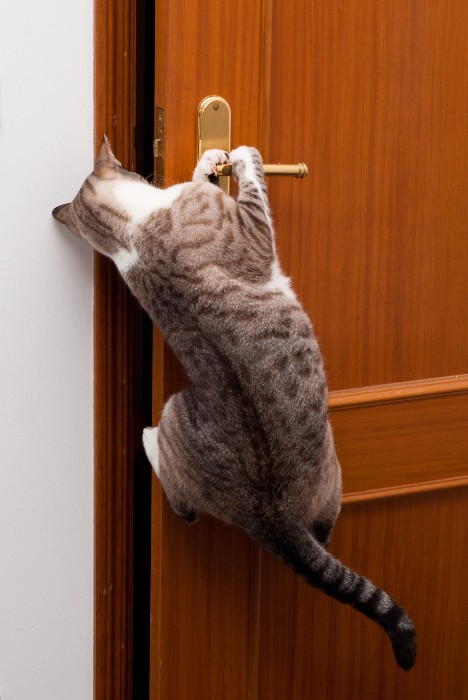
Settling In
With your cat contained in its crate, bring them inside the new house or hotel. If you have more than one, bring all the cats in before opening carrier doors. Limit access to one safe room, making sure it's secure. Set up familiar objects, including a litter box, food and water dishes, and any blanket or toys that your cat finds soothing. When you open the crate door, let your cat come out by themselves. If your cat responds well to calming aids, consider using them in your new space.
Keeping Your Cat Indoors
Slowly introduce your purr kid to their new home. As you expand your cat’s access from one room to other spots in the new home, you'll still want to limit where they go. Even if they are normally indoor/outdoor you’ll want to keep your cat inside for the first 14 days. When a cat's routine is changed or they're relocated to a new environment, they are more likely to become disoriented, and possibly injured or lost.
You Got This
Every purr kid is different and will react to traveling and a new home or environment differently. Some are fearless felines who love to travel with their people, some are more homebodies, and others haven’t traveled so it’s hard to say HOW they will react.
You know your cat better than anyone, but you likely also know that cats are unpredictable at times, so please use caution whenever you are traveling with your purr kid.
Want to snag some of the products we mentioned in this helpful article? Here's a curated Amazon shopping list for you so you can get things in one visit.
Looking for more information to help with your move? Check out this article from Preventive Vet by clicking here. Preventive Vet also has an exclusive offer with PetHub providing all of our users a free copy of 101 Tips books – one specifically for cats!



